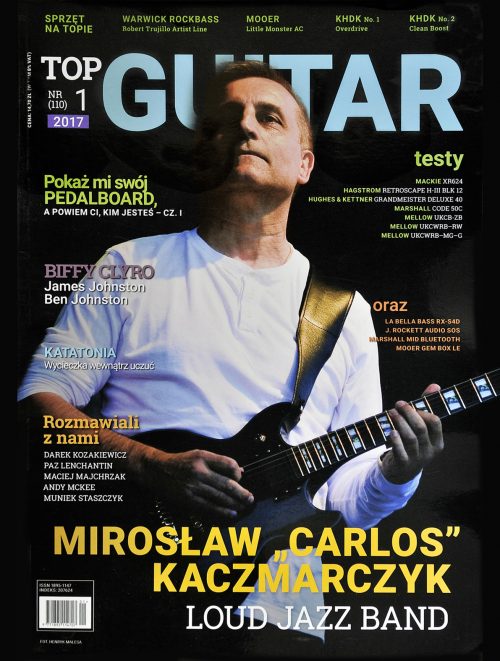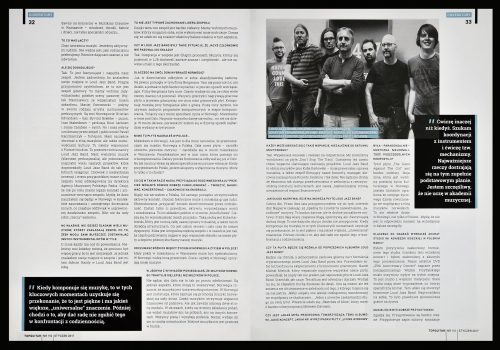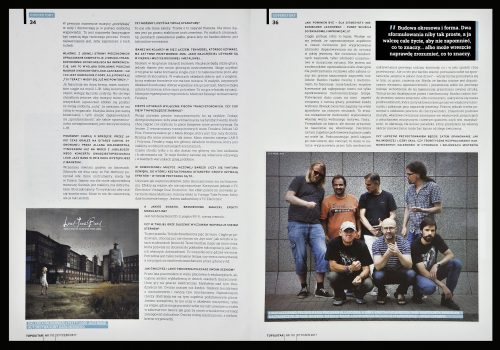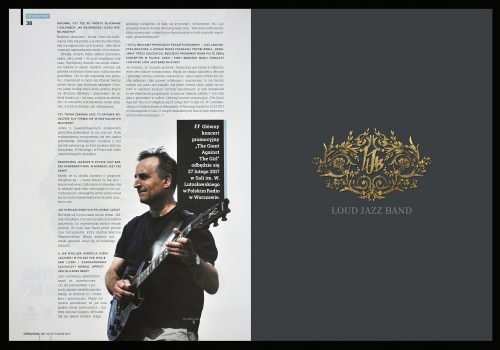Top Guitar
– article translation –
We met the leader of one of the most interesting, stylistically and ethnically eclectic and long-running jazz bands in northern Europe right after he finished recording the album “The Giant Against the Girl” in Agnieszka Osiecka’s studio in Polish Radio, Warsaw.
TOPGUITAR: What does jazz mean to you?
MK: Jazz means not only music, but a lifestyle to me. It is a way to express your emotions and life experiences. There are things you cannot say with words. A lot of people choose to express their lives through sounds because it seems easier to them. Jazz appeared in my life a long time ago along with other music genres. At the same time I was inspired by Hendrix and Wes Montgomery. I listen to and learned with The Beatles, Led Zeppelin, Deep Purple and Santana. I watched Frank Zappa concerts and Leonard Bernstein’s symphonic mornings. I was inspired by Ewa Bem, as well as Novi Singers’ rendition of Chopin. I played electric guitar at modern musicshows at the National Opera and played Arne Nordheim’s compositions live at the Fryderyk Chopin University of Music. I also played a lot in Warsaw’s theatres next to some great actors. Just before I left Poland I had been a guitarist in the “Metro” musical. I’m sensitive to various kinds of music, especially to the masters of classical music. Our band, perhaps a bit paradoxically, is called “Loud Jazz Band,” but don’t let that fool you – we are no strangers to silence and minimalism.
You are aware that jazz is a niche. Was entering that niche a conscious decision?
That is a strange way to put it, but I will take it as an invitation to an argument. I think that both jazz and classical music require some sort of openness. Once you’re there, you can feel that you’re free and taking part in something grand and wonderful. Those who think they have heard jazz at shopping malls have not necessarily had the chance to encounter the art that is Jazz. My path was quite ordinary. First, I was inspired by some great artists, and then started to search for and create my own music. This unusual ‘niche’ is a way of life that one chooses. It doesn’t limit or restrict me. I am inside it. Not everyone wants to create music for the masses. Being and creating in this space is my conscious decision.
On one hand, jazz is becoming more and more available to the average listener: you can often hear it in a shopping mall. On the other hand, plenty of jazzmen play difficult music, which tends to tire instead of amaze its listeners. What is jazz supposed to be?
That is an interesting question… I’ll try to answer basing on our band. People we meet at our concerts and who get in touch with us tell us that they keep coming back to our music and discovering something new. I believe our music has many levels. There are those elements that reach the listeners immediately and those that intrigue them and encourage to keep looking for more. It happens subconsciously. A lot of this is intentional on our part, but there are also things that unleash themselves in places and manners that weren’t planned at all. The fact that musicians in Loud Jazz Band are so drastically different allows us to reach a wide range of listeners – the way it happened not so long ago at a concert in Multikino Ursynów in Warsaw – teenagers, adults, grandmas and kids, not just jazz experts.
What connects you all together then?
The desire to make music. We’re all active people. It doesn’t matter which type of jazz we prefer. The differences are what gives us more possibilities, not the other way round.
But you do get along, don’t you?
Yes. It’s fascinating and it’s the driving force behind our band. I’m glad because I found my place in Loud Jazz Band. I want to remind the readers that we are not a guitar band. What we have here are Polish jazz scene’s outstanding individuals: Wojtek Staroniewicz with the wonderful tone of a saxophone, Maciej Ostromecki – a one of a kind artist of the percussion instruments. Then there are my Norwegians: Kristian Edvardsen – bass, Øyvind Brække – trombone, Knut Løchsen and Jonas Cambien – synth. And then there is our one and only Paweł Kaczmarczyk, beloved both by the band and the public – the piano. I’m lucky to be working with the musical elite, but also people from the cultural scene. Here I must mention Piotr Iwicki. He is, after all, the author of the name Loud Jazz Band. He has played with us for many years (piano, drums) but also inspired many of our projects, which led Loud Jazz Band to such remarkable achievements. A man of unbelievable ingenuity and whole-hearted concern for the band’s fate, he is now the head of Polish Radio’s Music Agency. I can sense that year after year the relationships and understanding in our band are getting better. While I was in Norway I believe I learned a lot in terms of noticing and appreciating others, which resonates in efficient band activity. No one can ‘do it’ on their own.
Exactly. You don’t fall in line with plenty musicians who found a band just so that they can shine the brightest, leaving other players behind.
In my band everybody gets a say. Some of my friends say that we should have more guitar since it is my band; but I found my place in the band and I feel good where I am. Everyone in Loud Jazz Band is himself.
This isn’t typical of a band’s leader.
Thanks to this the band is interesting. We have outstanding musicians who can be themselves instead of following my instructions. I am glad I was able to find the perfect balance regarding this issue.
Has there ever been a situation in Loud Jazz Band where some members were not a good fit for the band?
Yes. Integrating within a band is a long process. Those musicians who appeared in LJB always got a chance and patience… but not all of them knew how to make use of that.
Why did you choose Norway to be your home?
Already as a child I discovered an inclination towards Scandinavia. Bergman’s films definitely played a part in that. Though it seemed like nothing ever happened in them, they were very distinct and moving in their own way. Bergman’s films were different. Quite often it seems to me that I do a lot of things differently. All the guitarists make guitar records, yet I am a guitarist and I don’t want to make one. I compose my music by a piano or with a guitar. I write the notes by hand, I don’t use any computer programs when I compose. This has a link to my life in Oslo. We live in a forest south of Oslo. Everything appears to be happening slowly there… and yet it happens. Strangely enough, in my “Norwegian” period I became most efficient as an artist.
And yet you recorded your album in Poland…
I live in Norway but it’s natural for me to move back and forth between Norway and Poland. The entire new album – seeding tracks, first themes – was born in my apartment in Warsaw. Paradoxically it is very silent there, which helps me compose. The next stage of creating the album happened already in Oslo. But on Hoża street there are some peculiar musical vibrations. When I come to Poland I’m focused only on music – maybe that’s why.
So what still attracts you to your home country? After all, you could function – that is, create, record, concert – in Norway just as well.
I never broke my ties with Poland. From the very beginning I kept in touch with people, although with a smaller group. The word “friend” had to be redefined by reality. The only ones left were those real and active, one step ahead of my thoughts and expectations. Those are the ones I pay homage to in the song “Mindfulness.” I’m glad because the quality of my friendships went up. One person who comes to mind is Kuba Karłowski, the author of our entire visuals and my artistic advisor. He is constantly and with all his heart at our disposal. Kuba is an integral part of our band and it often happens that we admire his wonderful covers for our albums and only then listen to our music.
Do you feel any differences between life in Norway and life in Poland?
A small room in a flat in Warsaw can be spectacular. I see a different space in Norway. Its calm and quiet favors my music.
In one of your interviews you mentioned that musicians are better treated in Norway than in Poland.
I don’t believe that it can be put as simple as that. There are, however, some aspects which may point to that. Norway understands that music is export goods. There is an institution there which is responsible for promoting Norwegian music across the world. Some of the musicians receive financial support from the state. But there are always two sides of the coin: when it’s time to hand in applications there is no sight of any musicians on rehearsals or concerts. Everybody’s writing and submitting their applications. It often appears unnatural to me. After all, an office is not the place for a musician…
Can anybody apply for this support, regardless of their music genre?
Yes. You just fill in the application and wait for the response. We were honored for the album “Don’t Stop The Train.” We also receive support that lets us carry out our projects. Loud Jazz Band consists of eight musicians plus Kuba Karłowski – my right hand and the man in charge of visuals; then there is the crew that films our concerts, the manager, Ricardo the bus driver, backline and so forth. The economy of such a big venture when faced with the reality of cultural institutions is not our strongest suit, regardless of the financial support.
How long did it take you to record your newest Loud Jazz Band album?
Four days. I was preparing for two years for those four days! First, I waited for those most important, seeding themes to fall into my lap. It’s very strange but those first tiny themes and phrases give you faith and energy for a long, tiresome yet fascinating adventure ahead of you. They give you strength not to give up on your way. When you’re composing music, it’s those key moments when you become convinced that what you’re doing is beautiful and has a bigger, universal meaning. Later it’s all about not losing that feeling when you’re faced with reality.
Is this album going to be different from others by Loud Jazz Band?
It’s both going to be different and keep in line with the main sound that Loud Jazz Band has perfected over the years. I let myself experiment more with the guitar. Even Michał Mielnik, who wonderfully records all our albums, said that I’ve never before played like I do on this album. I play the way I feel. This album is brave and mature. I believe I’ve been able to distance myself from the details. They are important, but their importance shifts depending on your point of view. It is as if they went under some intelligent transformation with some help from the person listening… One of the songs had to wait for a long time to get a name. Finally it happened: „Sketches of Mine,” which points towards a strong inspiration by Miles Davis.
Is there any keynote to this album? Any concept, like when the album “Living Windows” was all about the musical diversity of particular compositions?
The title of the album “The Giant Against the Girl” is very personal. My wife, who is an outstanding figure on the cultural scene in Norway, was brutally robbed of her life’s work created in collaboration with the elite of Norwegian musicians. It doesn’t happen only in Poland. I don’t think this is the right time to get into details.
Why did you choose Agnieszka Osiecka’s Studio at the Polish Radio to record your album?
I was positively surprised by the sound of this studio. We played a concert there before and I was pleased by the acoustics of that place. Our last DVD “25th Anniversary Concert” recorded by the unforgettable Wojtek Przybylski also had an understandable impact on choosing that studio. It’s a place with great traditions. Old studios have old equipment, which creates a peculiar atmosphere. We managed to create our sound right there. We recorded it in one take. It was real, spontaneous live playing!
You had to be well-prepared.
That’s true. Preparations are very important. I prepare the notation, the arrangement. At some point the musicians “swallow” the notes and deliver them in the form of a personal expression. It’s really fascinating to be a part of the creative process. The most important thing later on is not to forget those notes.
Exactly. On one hand, meticulously perfected compositions, on the other – some space left for improvisation. How exactly does it look at recordings and concerts – how much and of what is determined up front, and how much is done “here and now” and will never happen again?
I’m fascinated by elaborate forms: I like constructions, parts, preludes, bridges, codes etc. Additionally of course I would love for the musicians to be able to break through all these restraints with their own sound. I think they do it masterfully. Loud Jazz Band’s reality is music that is the sum of constructions and both planned and unplanned improvisations.
Let’s talk about the equipment for a while. For a while you played Allan Holdsworth’s Carvin, but on your 25th anniversary concert in 2014 you could be seen with Ibanez…
I played it earlier as well. Pet Metheny borrowed instruments from me twice when he was in Poland. Ibanez has the proper scale. Sustain is stable, it has a good balance. It’s tuned the way it should be. That’s enough to feel comfortable. It may sound unbelievable but that’s the way I am.
Can we count on your signature?
It doesn’t depend on me. You’d have to ask Ibanez. For me it’s simply a stable instrument. With small adjustments, for example strap suspension, it works very well for me – it’s naturally balanced.
I don’t associate Ibanez with jazz. The model you use has active EMG pickups, which are usually used in rock and metal music.
With this guitar I look for various sounds. On the album you’ll hear other guitars, but Ibanez is the main instrument. I can achieve a single-coil sound on this guitar. Not necessarily in order to imitate a Stratocaster. In bigger groups a single is a good solution because there is no space for a larger sound. In small, intimate groups a humbucker fills the space and glues it together. I have in my guitar those sounds which I need. It works every time. I have five copies of this model. I have also ten Fender amplifiers.
You used to work with nothing but amplifiers. Did anything change in that regard?
I still use solid state amplifiers because they’re “fast”. I add a compressor to soften the amplifier. When I want to play something faster I’m restrained by valve amplifiers. They’re lazy. When it comes to amplifiers I have Fender Deluxe 112 Plus. I compared it to Mesa Boogie, which is twice as expensive. They sound almost the same to me. I also have an old LAB5 and a Polyton. Fenders have this main sound ingredient which is stable in various sceneries.
It’s often all about finding that right main tone without looking for it and getting frustrated. Those Fenders of mine always resonate well and play similarly in different conditions.
In modern jazz music sound texture is very important. In order to shape it guitarists often use effects – in your case they are…
I use as few effects as possible because I want to focus on phrasing. Effects are important, but not most important. I use TC Electronic Vintage Dual Distortion. It was recommended to me by a Norwegian guitarist Hans Mathisen. Another effect is Vintage Tube Primer, which gives the sound of a valve. I’m pleased with TC Electronic.
How about anything extra, peculiar sounds or modulating effects?
There’s also Boss DD-3 delay, RV-5 reverb, often tremolo…
Do I correctly sense an inspiration with Mike Stern in your music?
That’s true. It was twenty-five years ago. I still admire him, though I no longer try to be him like in my college years (laughter). Now I’m more inspired by silence, which allows me to reach both inspiration and my own experience. It’s all somewhere within me. All you need is to slow down, or even stop, and not race after the opportunities given by iPhones etc.
How do you practice and what kind of practice do you recommend to your students?
Over the years I worked in many educational establishments. Currently, I teach in two music schools. I teach electric guitar. I thought about this for twenty years. I practice differently than I used to. I try to find coordination with my instrument and practice so-called mechanisms. The most important things are tuned on the most basic level. I’m glad that I don’t teach at any musical academy, but at a stage when I can instruct my students on the basics: how to play to be able to react naturally at the right moment. I practice a certain elasticity, not specific expressions.
What should be the starting point to conscious improvisation for any guitar player?
I constantly try to do it better. It seems to me that the most important thing to do in your practice is to learn how to adapt to a given situation. It’s not about learning specific moves but learning how to take part in a musical scenario. I’m not a fan either of telling jokes to keep a conversation alive and fill the silence or of playing well-studied moves – so called “licks.” I very rarely practice with a metronome because I’m more fascinated by creating the best possible time together than by executing the metronomic tempo. I devote a lot of time to another issue that has to do with a guitar’s nature, because every sound can be played in many different ways on various chords. It offers amazing possibilities when it comes to creating your own version of a given theme or phrase. I love basics, but I must admit that learning how to practice properly on an elementary level took me many years. To sum up: if I choose an instrument to practice it means I have a well-trained mechanism that activates a certain command of what and how I want to practice. But, what’s also very important, I let myself spontaneously “open another door” – thus changing the form of interacting with what I’m playing. I think allowing for this element of spontaneity and letting yourself into this mysterious spaced called art is very important. After all, it functions by different rules and mechanisms. It happens very often that when we’re very tired or we’re daydreaming our subconscious is activated, which then instinctively directs us in the right directions and shows us who we really are. But then you have to remember how to get back to reality. It’s easier when you know the basics of music, proper practice together with having a good ear and playing a lot, that is all that constitutes the so-called musicality. Finally a paradox which I know from my own experience: not practicing can be better than practicing incorrectly.
So what makes for a better preparation: mastering as many scales as possible, theoretical deconstruction of harmonic relations in the songs and solos of great artists of the genre, or simply listening to and absorbing as much music as possible?
Periodic structure and form. Two seemingly easy phrases, and yet I have struggled all my life not to forget what they mean… or maybe to finally understand it.
Sound, theme, phrase, musical sentence, part, piece – it all has to harmonize all the time. A single sound has its proper place in the entire piece, just like a spot on a painting which is supposed to be there and only there. Is it all without reason or meaning? Or maybe this sound creates a word, this word generates another one; this in turn produces a short thought, which may become a longer reflection and lead to some sort of conclusion – either instantly or after a while. And it’s all phrased, in a whisper or in a scream, like in Bergman’s films.
Do you think that jazz is a genre dedicated only to formally educated musicians?
One of the world’s best pianists admitted once that he can’t read notes. The lack of musical education is not a restriction of any kind. The ability to read notes is not a guarantee that you’ll be a good musicians. There are many talented musicians in Norway and Poland.
The jazz milieu in Poland is very conservative. Is this also the case in Norway?
I think it’s more about the proportions. There are always conservative, traditional groups wherever you go – and maybe that’s a good thing. But parallel to them exists the avant-garde, which itself may one day become conservative… who knows!
How would you evaluate to state of Polish jazz?
I won’t talk about that. However I’d like to distinguish Polish jazz musicians because they represent a very high standard. For a while there was a pianist in Loud Jazz Band who listened to Marcin Wasilewski. A young, ambitious Norwegian jazzman was learning from a Polish pianist.
And what about the state of Polish jazz scene in terms of the audience’s numbers and commitment? In other words – is there anyone to play for?
Jazz creates a peculiar zeal to participate, or to search, due to a certain incompleteness. I think this pertains to both musicians and audience. You can never say that you’ve accomplished what you wanted and now you can reap the benefits. We enter new stages, we’re glad that we could fulfill them. And we’re on our way to the next goal… The same goes for the audience, which evolves and dynamically participates in our common search.
And so we come back to the beginning of our conversation – jazz as a difficult, yet worthy of learning and “taming” genre. You’re going to promote your new album with a series of concerts in Poland. Where and when will we be able to see and hear Loud Jazz Band live?
I believe that both jazz and classical music can be easy for a listener if they’re properly executed. I think it may be more about some decisions and a kind of personal attitude. If you’re in the mood for musing and letting yourself float away with dreams and reflections then you don’t have to avoid either jazz or classical music. But if you want to “go all the way” in the “big world” of shopping malls, then you’ll be getting it in appropriate proportions: amidst noise and chaos – this pseudo-jazz coming from speakers in the ceiling. The main concert promoting “The Giant Against the Girl” will be held February 27th in W. Lutosławski’s Hall in Warsaw’s Polish Radio. In Norway it will be held on April 21st in Cosmopolite in Oslo. We will inform about any additional concerts on the go.




